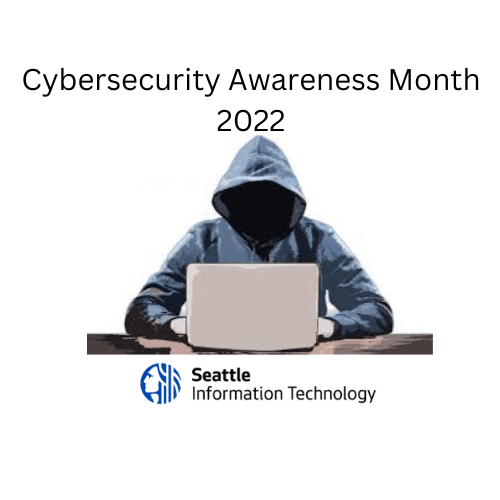by Greg Smith
October is National Cybersecurity Awareness Month. One of the key messages for this year’s cybersecurity awareness campaign is “See Yourself in Cyber”. While securing the City’s technology systems can often be complicated and nuanced, this year’s theme spotlights the fact that a huge part of successful cyber defense comes down to people.
As we work to build a resilient Seattle community, each of us has a role to play. Seattle IT staff across all parts of the department help to protect our systems by implementing processes, technology, and roles that promote security. Security teams do diligent work each day, yet they alone cannot protect our IT ecosystem without everyone doing their part. Weaving security-minded approaches into every aspect of technology delivery is how all of us in Seattle IT can contribute to this critical aspect of what we do. We also rely on the help and hard work from many technology, business, and public service teams across the entire City of Seattle organization.
To the many individuals who help secure the City, thank you. Every day that we prevent malicious activity, it is due to the vigilant, cyber-minded individuals like yourself who take extra steps to report threats or implement strong security practices.
We would like to take time this October to encourage everyone to follow four steps highlighted by the Cybersecurity and Infrastructure Security Agency (CISA) and the National Cybersecurity Alliance (NCA):
- Think Before You Click: Recognize and Report Phishing: If a link looks a little off, think before you click. It could be an attempt to get sensitive information or install malware.
- Update Your Software: Don’t delay — If you see a software update notification, act promptly. Better yet, turn on automatic updates.
- Use Strong Passwords: Use passwords that are long, unique, and randomly generated. Use password managers to generate and remember different, complex passwords for each of your accounts. A passwords manager will encrypt passwords securing them for you!
- Enable Multi-Factor Authentication: You need more than a password to protect your online accounts, and enabling MFA makes you significantly less likely to get hacked.

Greg Smith is the Chief Information Security Officer and Director of the Security and Infrastructure Division within the Seattle Information Technology Department. He has over 25 years of experience in public sector technology and is responsible for the City’s cybersecurity program as well as the strategy and service delivery of foundational technologies on which City business operates. He leads and directs a broad range of highly skilled teams tasked with delivering secure, compliant, and reliable technology for the City’s many resident-facing departments.
